Published 2021-09-14
Keywords
- Tetraselmis sp,
- Culture medium,
- Photobioreactor,
- Aquaculture,
- Gompertz
How to Cite
Abstract
Microalgae play a very important role in the food chain of aquaculture, they have already been used in the nutrition and breeding of mollusks, shrimps and fish in their different stages of growth. Tetraselmis sp. is a recognized microalgae for its applications as live feed in aquaculture and its grow could vary according to the culture conditions. In this sense, different growing conditions such as culture medium, commercial fertilizer, photoperiod (12:12 and 24: 0) and salinity (0-55 g l-1) to obtain different growth kinetic parameters. The best growing conditions were achieved with a commercial fertilizer, a 12:12 photoperiod, salinity of 35 g l-1, a specific growth rate of 1,071 d-1, doubling time of 0.64 days, yields (Yx/s) of biomass with respect to the consumption of nitrate, phosphorus and ammonium of 4.3; 37.7; 10.5 (g g-1) respectively, with a protein content of 55% (w/w). In addition, the Gompertz model for biomass production was evaluated, presenting a good fit (r2 = 0.9) between the model and the experimental results.
Downloads
References
[2] Spolaore P, Joannis-Cassan C, Duran E, Isambert A. Commercial applications of microalgae. Journal of Bioscience and Bioengineering. 2006;101(2):87-96.
[3] Michels MHA, Vaskoska M, Vermuë MH, Wijffels RH. Growth of Tetraselmis suecica in a
tubular photobioreactor on wastewater from a fish farm. Water Research. 2014;65(0):290-6.
[4] Torrentera-Blanco L, Tacon AGJ. La producción de alimento vivo y su importancia en la acuicultura. 1989. Consultado Marzo 18 de 2008 en: http://www.fao.org/documents/; 2008.
[5] Arredondo B, Voltolina D. Métodos y herramientas analíticas en la evaluación de biomasa microalgal. nomoeste CdId, editor. México; 2007.
[6] Guillard RRL, Ryther JH. Studies of marine planktonic diatoms I.Cyclotella nana Hustedt
and Detonula confervacea Cleve. Can. J. Microbiol. 1962;8:229-239.
[7] Acosta A. Estudio de la intensidad lumínica y fuentes de carbono en el cultivo de
Haematococcus pluvialis a nivel de fotobiorreactor de laboratorio (tesis de maestría). Medellín: Universidad de Antioquia; 2007.
[8] Collos Y, Mornet F, Sciandra A, Waser N, Larson A, Harrison PJ. An optical method for the rapid measurement of micromolar concentrations of nitrate in marine phytoplankton cultures. Journal of Applied Phycology. 1999;11.
[9] Saudagar PS, S. Optimization of nutritional requirements and feeding strategies for
clavulanic acid production by Streptomyces clavuligerus. Bioresource Technology.
2007;98:7.
[10] Çelekli A, Yavuzatmaca M, Bozkurt H. Modeling of biomass production by Spirulina platensis as function of phosphate concentrations and pH regimes. Bioresource Technology.
2009;100(14):3625-9.
[11] Doran P. Bioprocess Engineering Principles. Press A, editor. London; 1995.
[12] Sarkar PB, Ghosh, NN. Studies on nessler’s reagent part I. Anal. Chim. Acta. 1995;13:95-
199.
[13] Quevedo CM, S; Acosta A. Scenedesmus sp. growth in different culture mediums for microalgal protein production. VITAE. 2008;15(1):7.
[14] Metaxatos A, Panagiotopoulos C, Ignatiades L. Monosaccharide and aminoacid composition of mucilage material produced from a mixture of four phytoplanktonic taxa. Journal of Experimental Marine Biology and Ecology. 2003;294(2):203-17.
[15] Sen B, Kocer MAT, Alp MT. Studies on Growth of Marine Microalgae in Batch Cultures:
IV. Tetraselmis suecica (Kylin) Butcher (Prasinophyta). Asian Journal of Plant Sciences. 2005;4(6):645-7.
[16] Ghezelbash F, Farboodnia T, Heidari R, Agh N. Effects of Different Salinities and Luminance on Growth Rate of the Green Microalgae Tetraselmis chui. Research Journal of
Biological Sciences. 2008;3(3):4.
[17] Singh SP, Sing P. Effect of temperature and light on the growth of algae species: A review.
Renew Sustain Energy Rev. 2015;50:13.
[18] Vanthoor-Koopmans M, Cordoba-Matson M, Arredondo-Vega B, Lozano-Ramírez C, Garcia-Trejo J, Rodriguez-Palacio M. Microalgae and Cyanobacteria Production for Feed and Food Supplements. In: Guevara-Gonzalez R, Torres-Pacheco I, editors. Biosystems Engineering: Biofactories for Food Production in the Century XXI: Springer International Publishing; 2014.p. 253-75.
[19] Soto-Leon S, Zazueta-Patrón E, Piña- Valdez P, Nieves-Soto C, Reyes Moreno C,
Contreras-Andrade I. Extracción de lípidos de Tetraselmis suecica: proceso asistido por
ultrasonido y solventes. Revista Mexicana de Ingeniería Química. 2014;13(3):253-275
[20] Meseck SL, Alix JH, Wikfors GH. Photoperiod and light intensity effects on growth and
utilization of nutrients by the aquaculture feed microalga, Tetraselmis chui (PLY429).
Aquaculture. 2005;246(1-4):393-404.
[21] Contreras F. Manual de Técnicas hidrobiológicas. Trillas, editor. México; 1994.
[22] Blanken W, Alix JH, Wikfors GH. Predicting microalgae growth. Algal Research Elsevier
BV. 2016;14:10.
[23] Sacristán de Alva M. Luna Pabello M, Orta Ledesma MT, Cruz Gómez MJ. Carbon, nitrogen, and phosphorus removal, and lipid production by three saline microalgae grown
in synthetic wastewater irradiated with different photon fluxes. Algal Res. 2018;34(July):97-103.
[24] Patel A, Barrington S, Lefsrud M. Microalgae for phosphorus removal and biomass
production: A six species screen for dualpurpose organisms. GCB Bioenergy. 2012;
4(5):485-495.
[25] Saldarriaga N, Acosta Cárdenas A, Atehortua L. Remoción de nitratos y fosfatos de aguas
residuales de tratamiento primario empleando la microalga Dunaliella salina. III Simposio sobre Biofábricas La Biotecnología como Herramienta para el Desarrollo y el Bienestar. 2007.
[26] Li Z. A novel potential source of b-carotene: Eustigmatos cf. polyphem (Eustigmatophyceae) and pilot b-carotene production in bubble comumn and flat panel photobioreactors. J Chem Inf Model. 2012;117:6.
[27] Abalde J, Cid A, Hidalgo JP, Torres E, Herrero C. Microalgas: Cultivo y aplicaciones. Coruña: Universidade da Coruña; 1995.
[28] Peña MRdl, Villegas, C. T. Cell growth, effect of filtrate and nutritive value of the tropical
Prasinophyte Tetraselmis tetrathele (Butcher) at different phases of culture. Aquaculture
Research. 2005;36:1500-8.
[29] Gómez Restrepo HJ. Hacia la sostenibilidad y competitividad de la acuicultura Colombiana.
Acuanal y Fedeacua. Programa de Transformación Productiva, PTP Colombia; 2014.
[30] Morris H, Quintana M, Almarales A, Hernández L. Composición bioquímica y evaluación de
la calidad proteica de la biomasa autotrófica de Chlorella vulgaris. Revista Cubana de
Alimentación y Nutrición. 1999;13:5.
[31] Okauchi M, Kawamura K. Optimum medium for large-scale culture of Tetraselmis tetrathele. Hydrobiologia. 1997;358(1):217-22.
[32] Mansouri M. Predictive modeling of biomass production by Chlorella vulgaris in a drafttube airlift photobioreactor. Advances in Environmental Technology. 2016;3:7.


